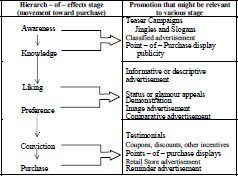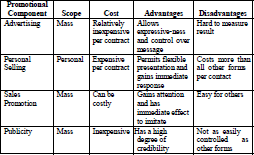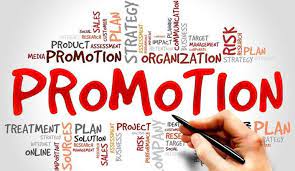Mutually satisfying exchange being the ultimate goal of marketing, the role of promotion, therefore, is to encourage such an exchange through linking communications with the product adoption process of the buyer.
Motivating the adoption of the promoted product as well as effecting the desired change in consumer behavior are the goals of the promotion function.
The attainment of these goals presupposes that the product purchase process is understood by the marketers before marketing communications are designed.
While there are many models that help to conceptualize the buying process, two very specific models that aid in understanding the buying process as well as in framing communication are: the ‘AIDA’ and ‘Hierarchy-of-effects’ models.
The AIDA acronym stands for Attention (also called awareness), Interest, Desire, and Action. According to the AIDA model, a marketer should begin by winning attention or gaining awareness, creating interest, inspiring desire, and precipitating the action for purchase, in the prospects in order to enable its product to be adopted by the target public.
Under the hierarchy-of-effects model, the buyer’s purchase decision is preceded by steps such as conviction about the product benefits, preference for the brand, liking for the brand, and knowledge relating to the benefits and features of the product, after awareness of the product has been gained.
Read Also: Explanation for the widespread use of Full–cost Pricing
The basic implication of these models is that the function of persuasive communication or promotion should be handled deftly at every stage of the buyer’s adoption process. Based on Lavidge and Steiner’s research, Gaedeke and Tootelian illustrate the various promotional tools that might be relevant to each stage of the hierarchy-of-effects model that is available to marketers for making marketing communications.

The Promotion Mix
In our daily life, we all are exposed to various tools of promotion aiming at communicating one thing or the other to us.
To illustrate this, while at home we come across advertisements when reading a newspaper, watching TV, listening to the radio, or even examining the water, electricity, or telephone bills; on our way to the office, similar communications face us on bus panels, roadside hoardings, neon signs, posters, and banners, etc.
At a retail shop, these take the shape of traffic builders, product displays, streamers, hangers, bins, etc., all sharing information relating to a specific product of a company.
Listed above are just a few types of the various promotional tools available to a marketer. Before proceeding, let us take a look at the definitions of the four major methods of promotion. These are advertising, personal selling, sales promotion, and publicity.
The committee on Definitions of the American Marketing Association defined these components as follows:
Advertising
Any paid form of non-personal presentation and promotion of ideas, goods, or services by an identified sponsor.
It includes the use of such media as magazines, newspapers, outdoor posters, direct mail novelties, radio, television, bus posters, catalogs, directories, programs, and circulars.
Read Also: Objectives of Pricing Policy in Marketing
Personal Selling
An oral presentation is a conversation with one or more prospective purchasers for the purpose of making sales.
Sales Promotion
Those marketing activities, other than personal selling, advertising, and publicity, stimulate consumer purchasing and dealer effectiveness such as non–routine selling efforts. These are usually short–term activities.
Publicity
Non-personal stimulation of demand for a product, service, or business unit by generating commercially significant news about it in published media or obtaining favorable presentation of it on radio, television, or stage. Unlike advertising, this form of promotion is not paid for by the sponsor.
Relative’s Advantages and Disadvantages of Promotion

Although definitions vary about the number of components that constitute promotion, marketing practice shows that almost all marketing activities influence the promotion function. Notably, packaging performs the promotion function in addition to providing protection to the product.
By incorporating creativity in its design, a package can add the ‘pick-me-up appeal to the product and also help to communicate its features, uses, and benefits more effectively.
The promotion aspect of packaging is witnessing a bit of revolution in Nigeria nowadays with the introduction of an innovative package in the field of consumer goods, for example, the package design of Pepsi and edible oils, etc.
Public relations, likewise, performs an important role in promotion insofar as it helps to create a favorable image of the firm and allows the public to experience better satisfaction in dealing with the firm.
High and consistent product quality, provision of superior customer services, and price promotions as a way of increasing short-term sales and compatibility between the character of distribution outlets and the product are the other ways that contribute to the promotion function of a firm.
Read Also: Objectives of Pricing Policy in Marketing
